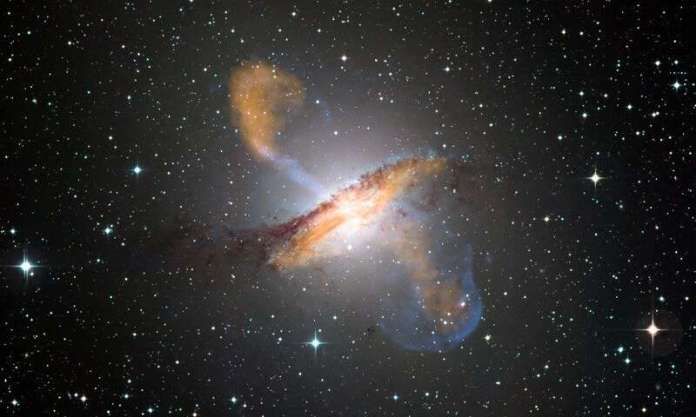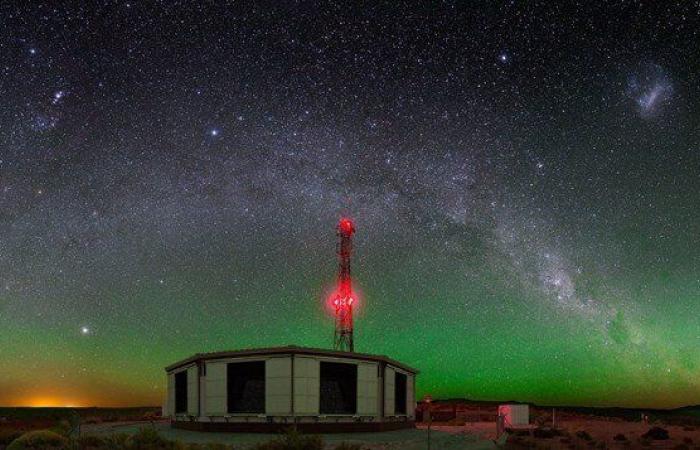Particles smaller than an atom race through the universe at almost the speed of light and are blown into space from somewhere in the cosmos.
A scientific collaboration at the Pierre Auger Observatory, in which researchers from the University of Delaware participated, measured the most powerful of these particles – ultra-high energy cosmic rays – with unprecedented precision. In doing so, they found a “kink” in the energy spectrum that sheds more light on the possible origins of these subatomic space travelers.
The team’s results are based on the analysis of 215,030 cosmic radiation events with energies above 2.5 trillion electron volts (eV) recorded by the Pierre Auger Observatory in Argentina over the past decade. It is the largest observatory in the world for studying cosmic rays.
The new spectral feature, a kink in the energy spectrum of cosmic rays at around 13 trillion electron volts, represents more than points shown in a diagram. According to Frank Schroeder, assistant professor at the Bartol Research Institute at the UD Institute for Physics and Astronomy, who was involved in the study with support from the university, humankind is getting one step closer to solving the riddles of nature’s most energetic particles from the Delaware Research Foundation. The research is published in Physical Examination Letters and Physics report D..
“Since the discovery of cosmic rays 100 years ago, the longstanding question was what accelerates these particles.” Schröder said. “The measurements from the Pierre Auger Collaboration provide important clues as to what we can exclude as a source. We know from previous work that the accelerator is not in our galaxy. Through this latest analysis, we can further confirm our earlier evidence of ultra-high energy. Cosmic rays are not just protons of hydrogen, but a mixture of nuclei made of heavier elements, and this composition changes with energy. ”
Between the “ankle” and the “toe”
Schroeder and UD postdoc Alan Coleman, who contributed to the data analysis, have been members of the Pierre Auger Collaboration for several years. UD officially joined the collaboration in 2018 as an institutional member. This team of more than 400 scientists from 17 countries operates the observatory, which covers an area of 1,200 square miles about the size of Rhode Island.

The observatory has more than 1,600 detectors, so-called water Cherenkov stations, which are distributed over the plateaus of the Pampa Amarilla (Yellow Prairie) and are overlooked by 27 fluorescence telescopes. Together, these instruments measure the energy that an ultra-high-energy cosmic ray particle releases into the atmosphere and provide an indirect assessment of its mass. All of this data – energy, mass and the direction from which these extraordinary particles came – provide important clues as to their origin.
Scientists previously thought that these ultra-high energy cosmic rays particles were primarily protons of hydrogen, but this latest analysis confirms that the particles have a mixture of nuclei – some heavier than oxygen or helium, such as silicon and iron.
On the curved graph depicting the energy spectrum of cosmic rays, you can see the kink – a steep, flattened section – between what scientists call the “ankle” and the beginning of the graph called the “toe”. ”

“We don’t have a specific name for it,” said Coleman, who was a member of the 20-person team that wrote the computer code and performed the numeric calculations required for the extensive data analysis. “I think we don’t have any more parts of the anatomy to name it,” he said jokingly.
Coleman was directly involved in the discovery and improved the reconstruction of the particle cascade that cosmic rays create when they hit the atmosphere to estimate energy. He also conducted detailed studies to ensure that this new turning point was real and not an artifact of the detector. The work of the data group lasted more than two years.
“Obviously it’s pretty minor,” Coleman said of the spectral kink. “But every time you see a bump like this, it signals that the physics is changing, and that’s very exciting.”
It’s very difficult to determine the mass of the incident cosmic rays, Coleman said. However, the measurement of collaboration is so robust and precise that a number of other theoretical models from which cosmic rays of ultra high energy originate can now be eliminated while other paths with greater force can be followed.
-

Scientists speculate that active galactic nuclei could be a source of high-energy cosmic rays. Active galactic nuclei are supermassive black holes in the center of galaxies that have gigantic jets of matter that do not fall into the black hole. Centaurus A shown here is an example of this class of galaxies in our galactic neighborhood, less than 20 million light-years from Earth. Photo credit: University of Delaware -

The flow of cosmic rays depends on their energy. The higher the energy, the rarer the cosmic rays. However, the larger figure shows that this relationship is not smooth. Several features indicate that something is happening at different energies, informally referred to by scientists as “knee,” “ankle,” and “toe,” along with the “new kink” as measured by the Pierre Auger Observatory Collaboration. The inset shows this new measurement in detail. Each feature can be interpreted as a change in the composition of cosmic rays at the respective energies. Photo credit: University of Delaware
Active galactic nuclei (AGN) and starburst galaxies are now in the running as potential sources. While their typical distance is about 100 million light years away, some candidates are within 20 million light years.
“If we learned what the sources are, we could investigate new details about what is going on,” Coleman said. What happens that makes these incredibly high energies possible? These particles could be from something we don’t even know. ”
The UD team’s ongoing research is focused on further increasing the measurement accuracy of ultra-high energy cosmic rays and extending the accurate measurement of the cosmic ray spectrum to lower energies. This would create better overlap with other experiments, Schröder said, such as the cosmic ray measurements from IceCube at the South Pole – another unique astroparticle observatory with large participation from the University of Delaware.
New data shows that cosmic rays are more complex than expected
A. Aab et al. Characteristics of the energy spectrum of cosmic rays above 2.5 × 1018 eV using the Pierre Auger Observatory, Physical Examination Letters (2020). DOI: 10.1103 / PhysRevLett.125.121106
A. Aab et al. Measurement of the cosmic radiation energy spectrum over 2.5 × 1018 eV with the Pierre Auger Observatory, Physical examination D. (2020). DOI: 10.1103 / PhysRevD.102.062005
Provided by the University of Delaware
Quote: New function in the energy spectrum of the strongest particles in the universe (2020, October 16), accessed on October 16, 2020 from https://phys.org/news/2020-10-feature-energy-spectrum-universe-powerful.html
This document is subject to copyright. Except for fair trade for the purpose of private study or research, no part may be reproduced without written permission. The content is provided for informational purposes only.
These were the details of the news New feature in the energy spectrum of the strongest particles in... for this day. We hope that we have succeeded by giving you the full details and information. To follow all our news, you can subscribe to the alerts system or to one of our different systems to provide you with all that is new.
It is also worth noting that the original news has been published and is available at de24.news and the editorial team at AlKhaleej Today has confirmed it and it has been modified, and it may have been completely transferred or quoted from it and you can read and follow this news from its main source.





